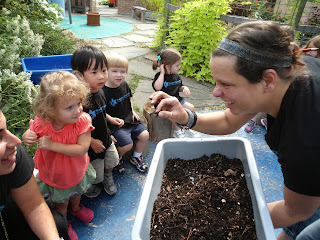 We've just finished celebrating the harvest festival of Sukkot. It is fall and we are ready to plant a new garden of winter crops. But, before we get to the planting, we need to understand what makes a garden grow. Healthy plants are the result of healthy soil. Not DIRT, but living, nutrient rich soil.
We've just finished celebrating the harvest festival of Sukkot. It is fall and we are ready to plant a new garden of winter crops. But, before we get to the planting, we need to understand what makes a garden grow. Healthy plants are the result of healthy soil. Not DIRT, but living, nutrient rich soil.
Soil is alive with microscopic bacteria, fungi, protozoa and nematodes. Soil will contain
earthworms, arthropods, and other visible crawling creatures. This week, our scientists explored three different soil samples, comparing and contrasting as they discovered.
Using investigative tools, their five senses, the students spent time at each sample. The bin containing the clay soil elicited the common description of "it's hard". Dallas, Texas has primarily a clay based soil, sometimes referred to as "black gumbo" because when it gets wet it sticks to everything! Another comment was "it's solid". What a great science word.
Another bin contained a sample of sandy soil. One boy noticed the temperature was different, "it is cold". Another scientist commented "this is mushy, but that one was hard". Another student observed "it feels like sand".
The last sample was silt, or loam. This sample was obtained from the compost bin. The students noted that the sample contained a lot crawling things, including worms and ants. In the wise words of one three year old, "it has stuff in it", referring to the sticks, leaves, and worms. But my favorite description was "it feels like soft pillows".
This experience required the students to explore in a multi-sensory manner. And of course, holding a wriggling, squirmy, slimy worm ranks in the Top Ten of sensory experiences.
AFTER THE SOIL INVESTIGATION WAS COMPLETED, WE DISCUSSED the life cycle of a plant. The students said that "you put a seed in the ground". I asked them which soil sample would be the easiest for a root to grow in. They agreed that the hard clay would not be good. But, the silt was too loose to hold up a plant. We experimented by combining portions from all three bins and obtained a nutrient rich soil that would hold water and support the structure of a growing plant. I reminded them that the reason they compost each day, is so that the garden beds will have rich humus to loosen the hard clay soil.
We took some of the humus and added it to the raised bed. Then they planted beet seeds and reminded me that the seeds needed water and sun.
To end the lesson, the scientists searched the garden for plants producing seeds. This scientist is dissecting a bean pod.










No comments:
Post a Comment